Report: Strategic Analysis of the Global Pharmaceutical Industry
VerifiedAdded on 2023/06/04
|12
|3023
|402
Report
AI Summary
This report offers a comprehensive strategic analysis of the global pharmaceutical industry. The analysis begins with an overview of the industry's growth, key drivers (disease prevalence, affordability, government policies), and challenges (slowing drug launches, regulatory issues). It then delves into a PESTLE analysis, examining the political, economic, social, technological, legal, and environmental factors impacting the industry. The report further utilizes Porter's Five Forces framework to assess the competitive landscape, evaluating threats of new entrants, rivalry among existing firms, bargaining power of buyers and suppliers, and the threat of substitutes. The conclusion highlights the industry's contributions while acknowledging current difficulties. The report uses data from 2017 and forecasts to 2021 to provide a comprehensive overview of the industry.
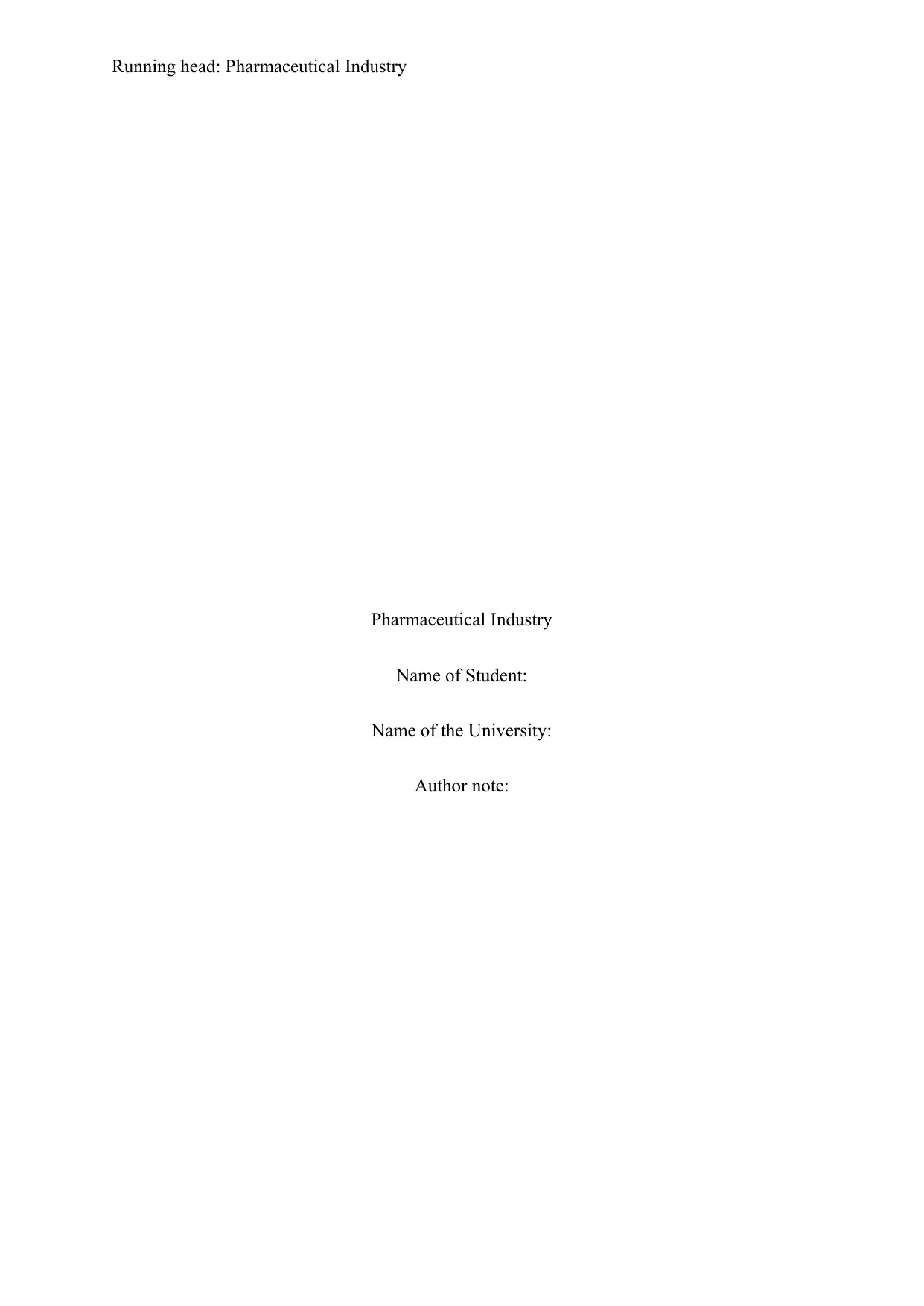
Running head: Pharmaceutical Industry
Pharmaceutical Industry
Name of Student:
Name of the University:
Author note:
Pharmaceutical Industry
Name of Student:
Name of the University:
Author note:
Paraphrase This Document
Need a fresh take? Get an instant paraphrase of this document with our AI Paraphraser
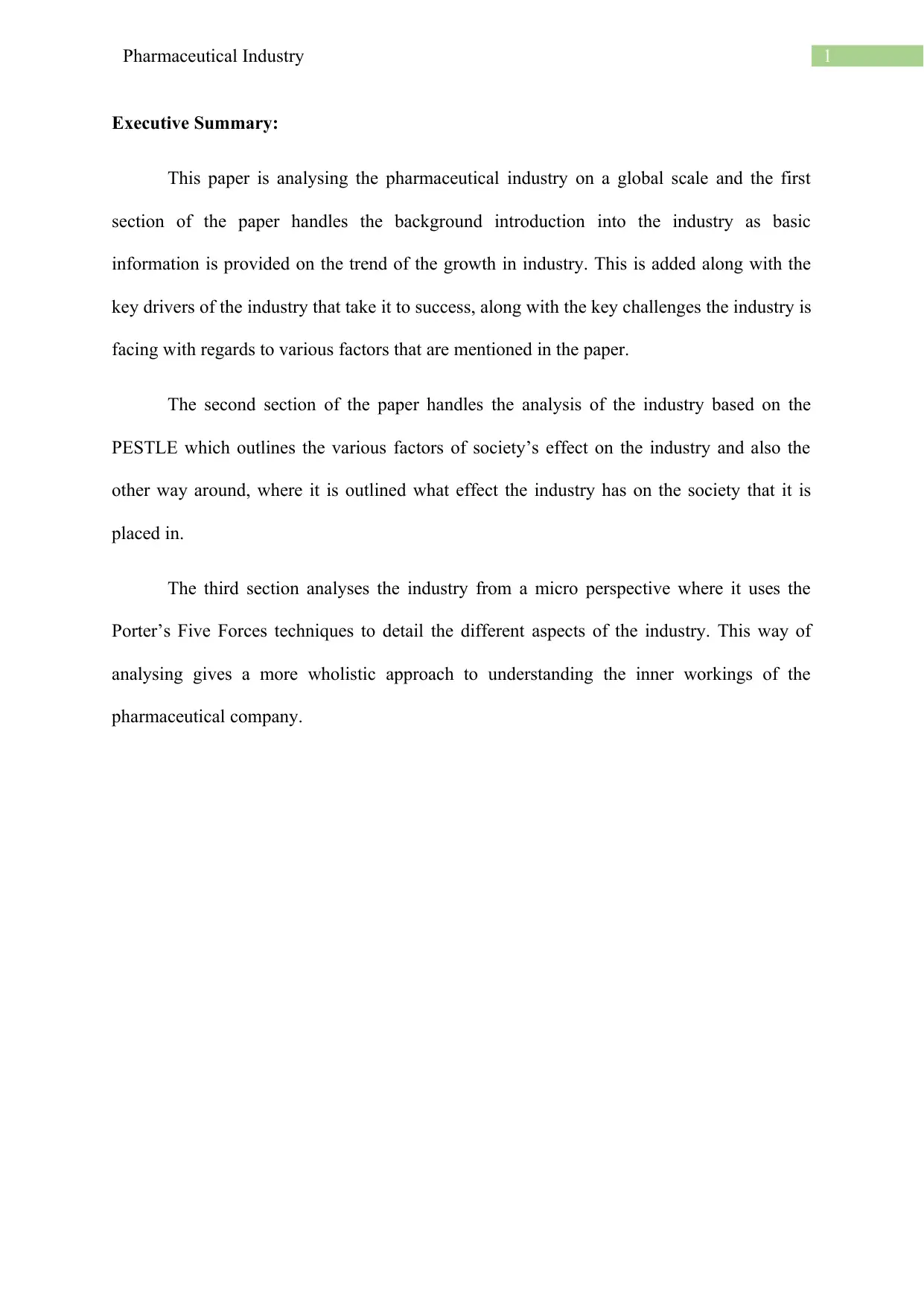
1Pharmaceutical Industry
Executive Summary:
This paper is analysing the pharmaceutical industry on a global scale and the first
section of the paper handles the background introduction into the industry as basic
information is provided on the trend of the growth in industry. This is added along with the
key drivers of the industry that take it to success, along with the key challenges the industry is
facing with regards to various factors that are mentioned in the paper.
The second section of the paper handles the analysis of the industry based on the
PESTLE which outlines the various factors of society’s effect on the industry and also the
other way around, where it is outlined what effect the industry has on the society that it is
placed in.
The third section analyses the industry from a micro perspective where it uses the
Porter’s Five Forces techniques to detail the different aspects of the industry. This way of
analysing gives a more wholistic approach to understanding the inner workings of the
pharmaceutical company.
Executive Summary:
This paper is analysing the pharmaceutical industry on a global scale and the first
section of the paper handles the background introduction into the industry as basic
information is provided on the trend of the growth in industry. This is added along with the
key drivers of the industry that take it to success, along with the key challenges the industry is
facing with regards to various factors that are mentioned in the paper.
The second section of the paper handles the analysis of the industry based on the
PESTLE which outlines the various factors of society’s effect on the industry and also the
other way around, where it is outlined what effect the industry has on the society that it is
placed in.
The third section analyses the industry from a micro perspective where it uses the
Porter’s Five Forces techniques to detail the different aspects of the industry. This way of
analysing gives a more wholistic approach to understanding the inner workings of the
pharmaceutical company.
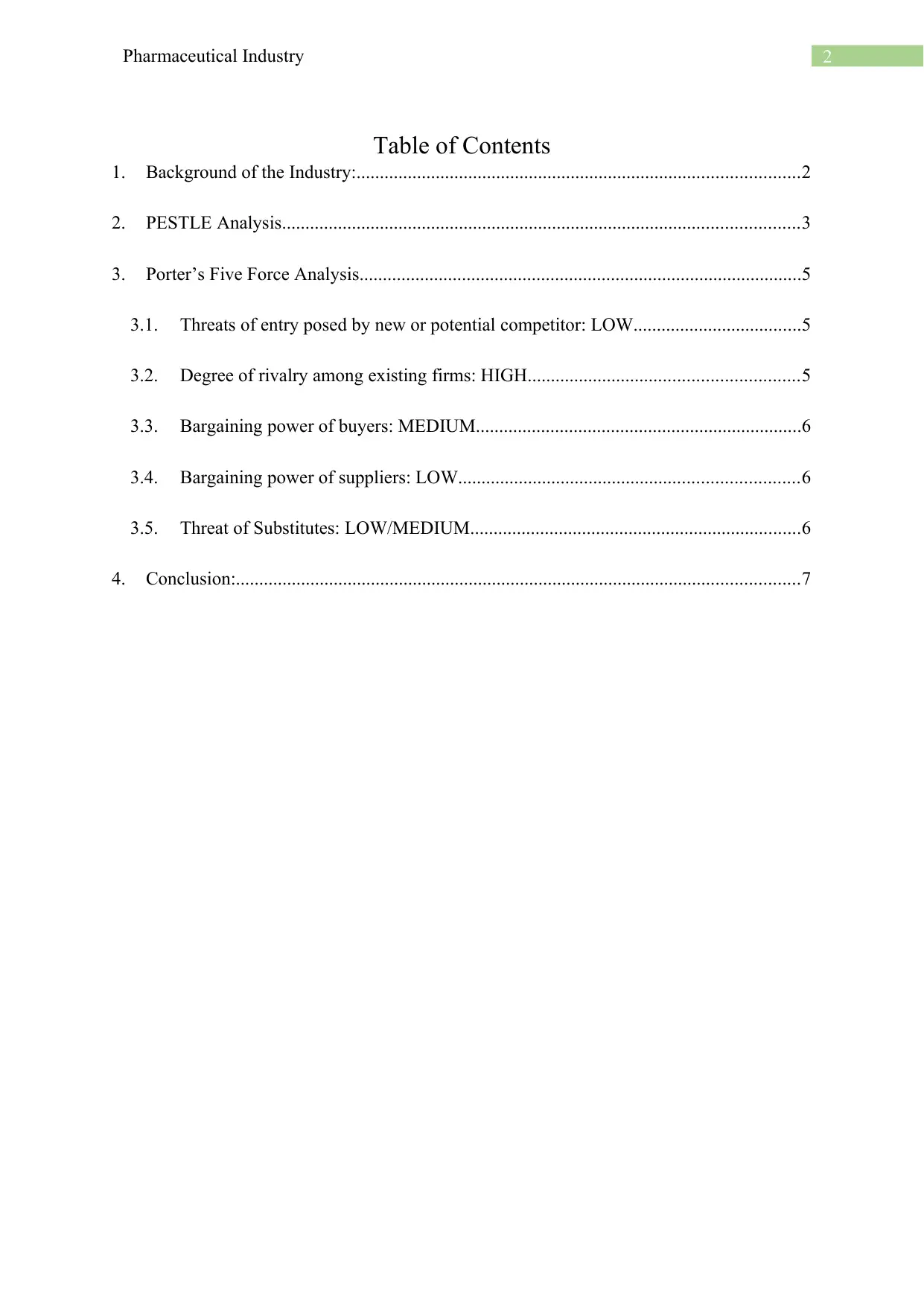
2Pharmaceutical Industry
Table of Contents
1. Background of the Industry:...............................................................................................2
2. PESTLE Analysis...............................................................................................................3
3. Porter’s Five Force Analysis...............................................................................................5
3.1. Threats of entry posed by new or potential competitor: LOW....................................5
3.2. Degree of rivalry among existing firms: HIGH..........................................................5
3.3. Bargaining power of buyers: MEDIUM......................................................................6
3.4. Bargaining power of suppliers: LOW.........................................................................6
3.5. Threat of Substitutes: LOW/MEDIUM.......................................................................6
4. Conclusion:.........................................................................................................................7
Table of Contents
1. Background of the Industry:...............................................................................................2
2. PESTLE Analysis...............................................................................................................3
3. Porter’s Five Force Analysis...............................................................................................5
3.1. Threats of entry posed by new or potential competitor: LOW....................................5
3.2. Degree of rivalry among existing firms: HIGH..........................................................5
3.3. Bargaining power of buyers: MEDIUM......................................................................6
3.4. Bargaining power of suppliers: LOW.........................................................................6
3.5. Threat of Substitutes: LOW/MEDIUM.......................................................................6
4. Conclusion:.........................................................................................................................7
⊘ This is a preview!⊘
Do you want full access?
Subscribe today to unlock all pages.

Trusted by 1+ million students worldwide
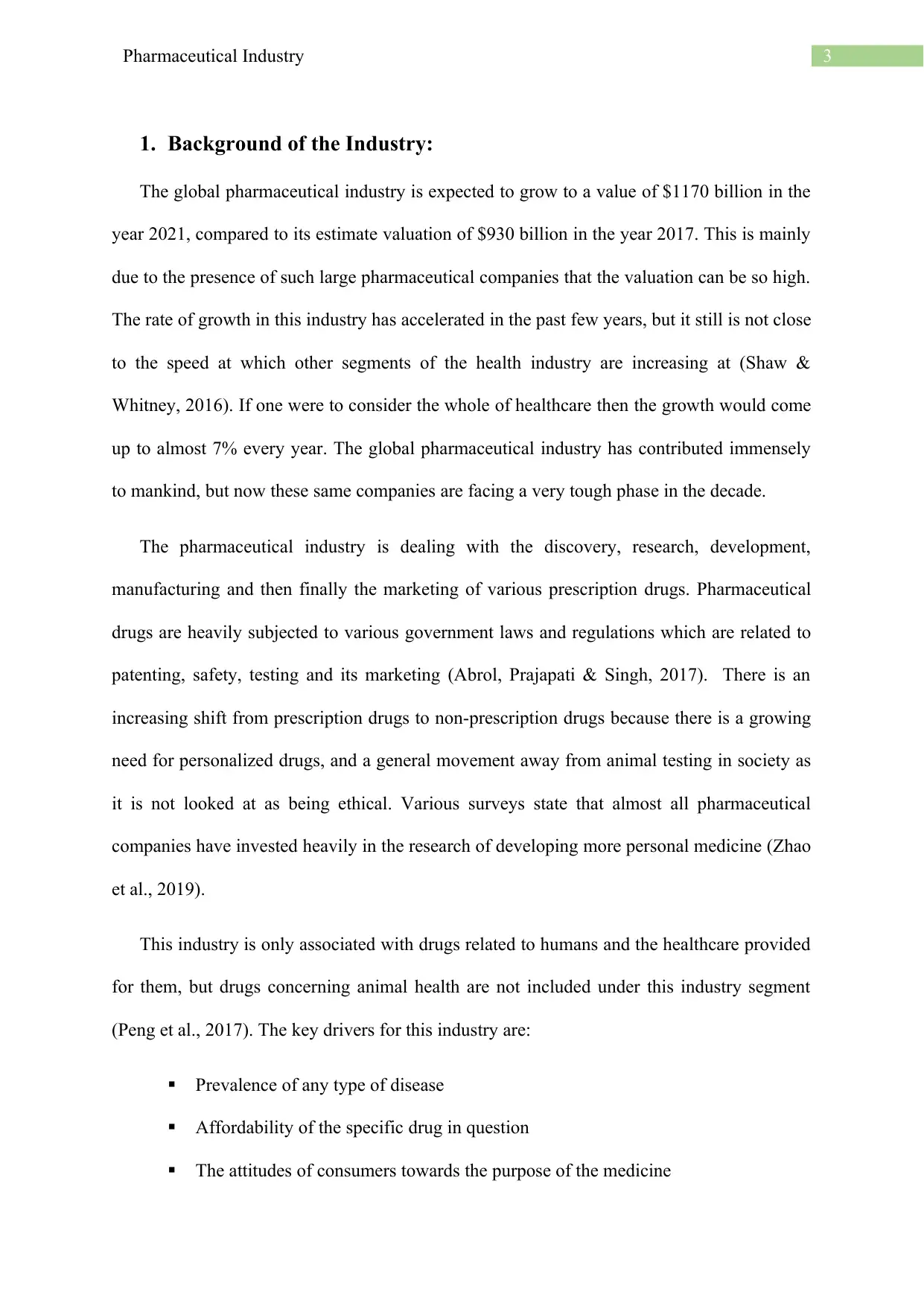
3Pharmaceutical Industry
1. Background of the Industry:
The global pharmaceutical industry is expected to grow to a value of $1170 billion in the
year 2021, compared to its estimate valuation of $930 billion in the year 2017. This is mainly
due to the presence of such large pharmaceutical companies that the valuation can be so high.
The rate of growth in this industry has accelerated in the past few years, but it still is not close
to the speed at which other segments of the health industry are increasing at (Shaw &
Whitney, 2016). If one were to consider the whole of healthcare then the growth would come
up to almost 7% every year. The global pharmaceutical industry has contributed immensely
to mankind, but now these same companies are facing a very tough phase in the decade.
The pharmaceutical industry is dealing with the discovery, research, development,
manufacturing and then finally the marketing of various prescription drugs. Pharmaceutical
drugs are heavily subjected to various government laws and regulations which are related to
patenting, safety, testing and its marketing (Abrol, Prajapati & Singh, 2017). There is an
increasing shift from prescription drugs to non-prescription drugs because there is a growing
need for personalized drugs, and a general movement away from animal testing in society as
it is not looked at as being ethical. Various surveys state that almost all pharmaceutical
companies have invested heavily in the research of developing more personal medicine (Zhao
et al., 2019).
This industry is only associated with drugs related to humans and the healthcare provided
for them, but drugs concerning animal health are not included under this industry segment
(Peng et al., 2017). The key drivers for this industry are:
Prevalence of any type of disease
Affordability of the specific drug in question
The attitudes of consumers towards the purpose of the medicine
1. Background of the Industry:
The global pharmaceutical industry is expected to grow to a value of $1170 billion in the
year 2021, compared to its estimate valuation of $930 billion in the year 2017. This is mainly
due to the presence of such large pharmaceutical companies that the valuation can be so high.
The rate of growth in this industry has accelerated in the past few years, but it still is not close
to the speed at which other segments of the health industry are increasing at (Shaw &
Whitney, 2016). If one were to consider the whole of healthcare then the growth would come
up to almost 7% every year. The global pharmaceutical industry has contributed immensely
to mankind, but now these same companies are facing a very tough phase in the decade.
The pharmaceutical industry is dealing with the discovery, research, development,
manufacturing and then finally the marketing of various prescription drugs. Pharmaceutical
drugs are heavily subjected to various government laws and regulations which are related to
patenting, safety, testing and its marketing (Abrol, Prajapati & Singh, 2017). There is an
increasing shift from prescription drugs to non-prescription drugs because there is a growing
need for personalized drugs, and a general movement away from animal testing in society as
it is not looked at as being ethical. Various surveys state that almost all pharmaceutical
companies have invested heavily in the research of developing more personal medicine (Zhao
et al., 2019).
This industry is only associated with drugs related to humans and the healthcare provided
for them, but drugs concerning animal health are not included under this industry segment
(Peng et al., 2017). The key drivers for this industry are:
Prevalence of any type of disease
Affordability of the specific drug in question
The attitudes of consumers towards the purpose of the medicine
Paraphrase This Document
Need a fresh take? Get an instant paraphrase of this document with our AI Paraphraser
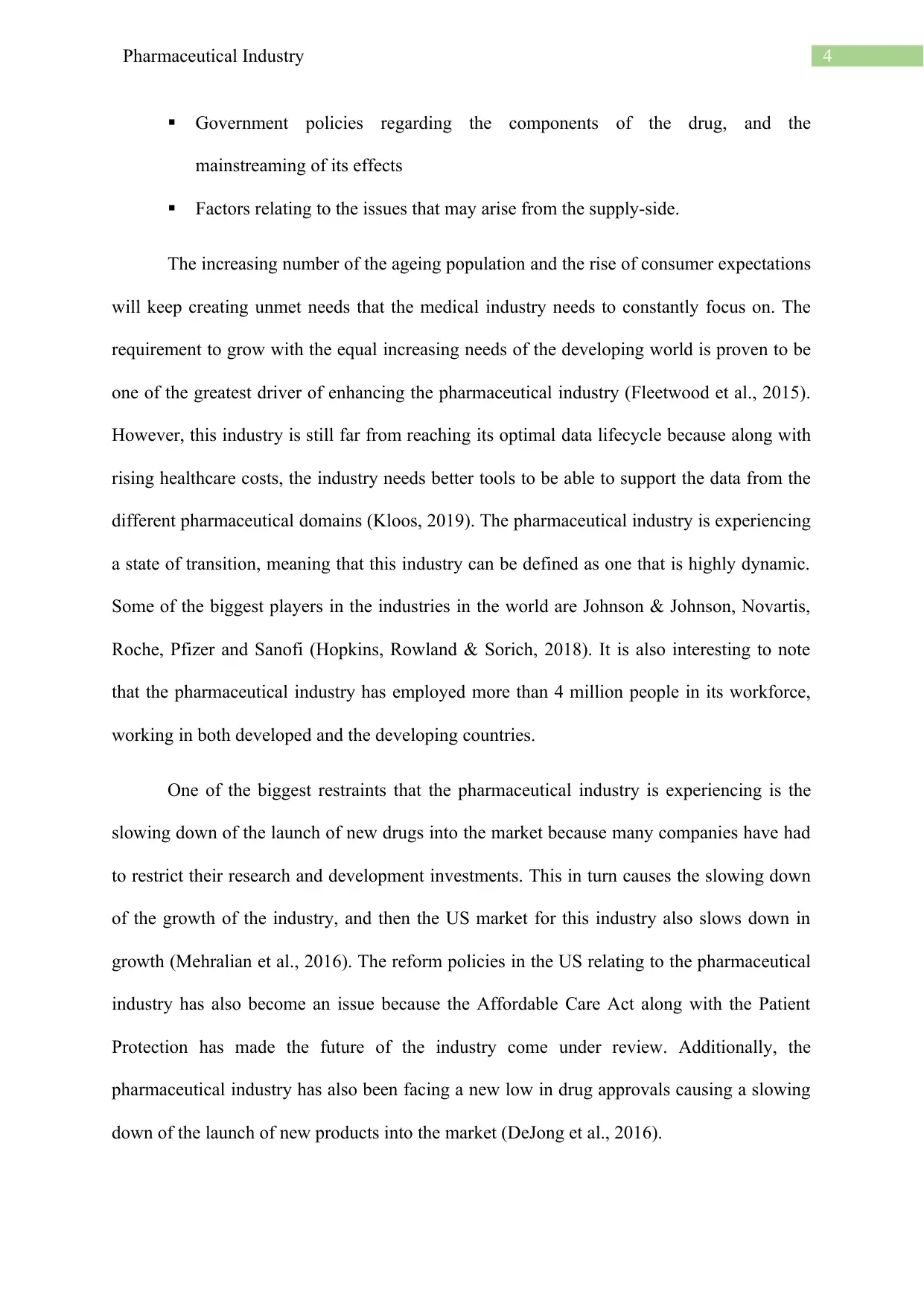
4Pharmaceutical Industry
Government policies regarding the components of the drug, and the
mainstreaming of its effects
Factors relating to the issues that may arise from the supply-side.
The increasing number of the ageing population and the rise of consumer expectations
will keep creating unmet needs that the medical industry needs to constantly focus on. The
requirement to grow with the equal increasing needs of the developing world is proven to be
one of the greatest driver of enhancing the pharmaceutical industry (Fleetwood et al., 2015).
However, this industry is still far from reaching its optimal data lifecycle because along with
rising healthcare costs, the industry needs better tools to be able to support the data from the
different pharmaceutical domains (Kloos, 2019). The pharmaceutical industry is experiencing
a state of transition, meaning that this industry can be defined as one that is highly dynamic.
Some of the biggest players in the industries in the world are Johnson & Johnson, Novartis,
Roche, Pfizer and Sanofi (Hopkins, Rowland & Sorich, 2018). It is also interesting to note
that the pharmaceutical industry has employed more than 4 million people in its workforce,
working in both developed and the developing countries.
One of the biggest restraints that the pharmaceutical industry is experiencing is the
slowing down of the launch of new drugs into the market because many companies have had
to restrict their research and development investments. This in turn causes the slowing down
of the growth of the industry, and then the US market for this industry also slows down in
growth (Mehralian et al., 2016). The reform policies in the US relating to the pharmaceutical
industry has also become an issue because the Affordable Care Act along with the Patient
Protection has made the future of the industry come under review. Additionally, the
pharmaceutical industry has also been facing a new low in drug approvals causing a slowing
down of the launch of new products into the market (DeJong et al., 2016).
Government policies regarding the components of the drug, and the
mainstreaming of its effects
Factors relating to the issues that may arise from the supply-side.
The increasing number of the ageing population and the rise of consumer expectations
will keep creating unmet needs that the medical industry needs to constantly focus on. The
requirement to grow with the equal increasing needs of the developing world is proven to be
one of the greatest driver of enhancing the pharmaceutical industry (Fleetwood et al., 2015).
However, this industry is still far from reaching its optimal data lifecycle because along with
rising healthcare costs, the industry needs better tools to be able to support the data from the
different pharmaceutical domains (Kloos, 2019). The pharmaceutical industry is experiencing
a state of transition, meaning that this industry can be defined as one that is highly dynamic.
Some of the biggest players in the industries in the world are Johnson & Johnson, Novartis,
Roche, Pfizer and Sanofi (Hopkins, Rowland & Sorich, 2018). It is also interesting to note
that the pharmaceutical industry has employed more than 4 million people in its workforce,
working in both developed and the developing countries.
One of the biggest restraints that the pharmaceutical industry is experiencing is the
slowing down of the launch of new drugs into the market because many companies have had
to restrict their research and development investments. This in turn causes the slowing down
of the growth of the industry, and then the US market for this industry also slows down in
growth (Mehralian et al., 2016). The reform policies in the US relating to the pharmaceutical
industry has also become an issue because the Affordable Care Act along with the Patient
Protection has made the future of the industry come under review. Additionally, the
pharmaceutical industry has also been facing a new low in drug approvals causing a slowing
down of the launch of new products into the market (DeJong et al., 2016).
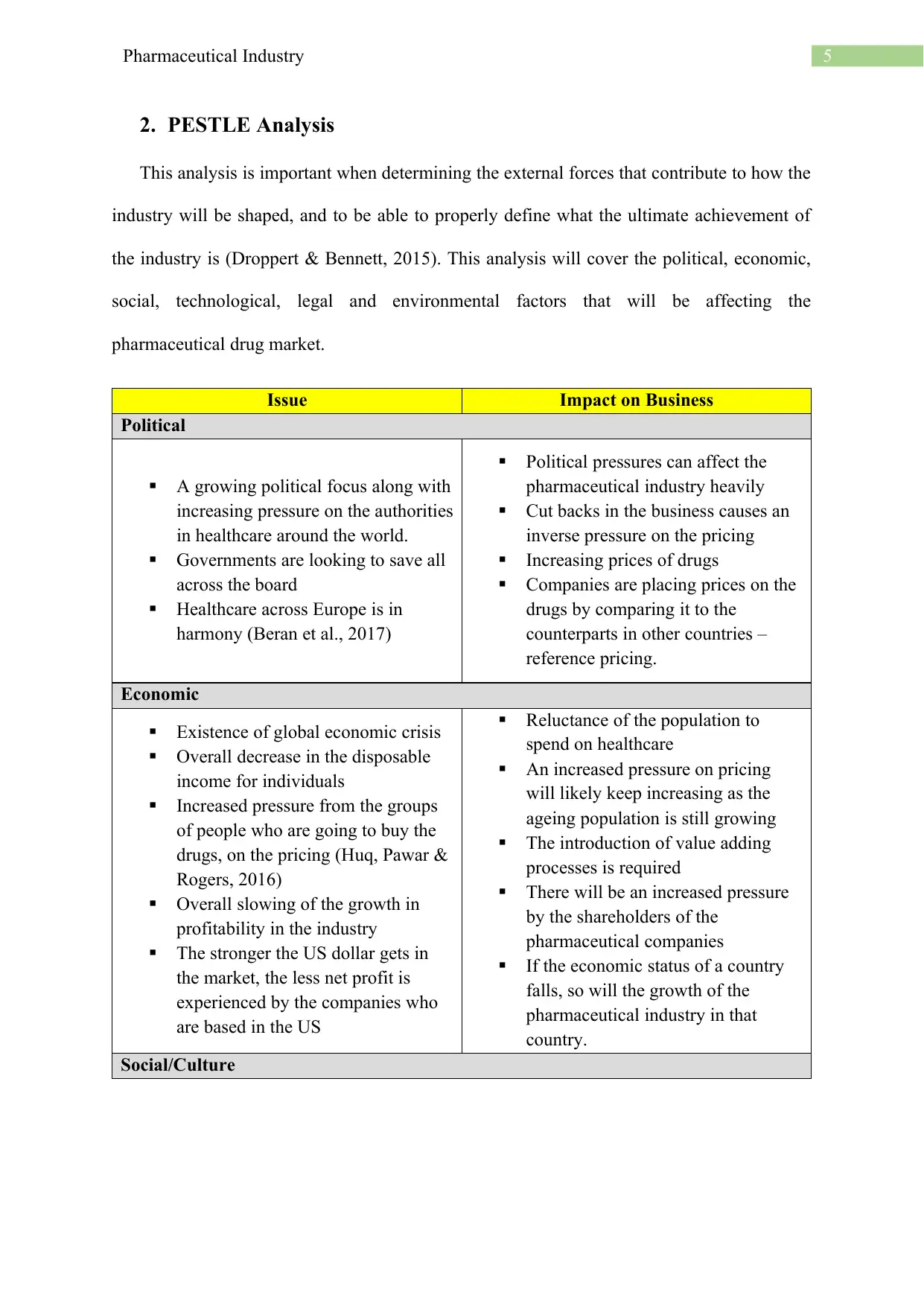
5Pharmaceutical Industry
2. PESTLE Analysis
This analysis is important when determining the external forces that contribute to how the
industry will be shaped, and to be able to properly define what the ultimate achievement of
the industry is (Droppert & Bennett, 2015). This analysis will cover the political, economic,
social, technological, legal and environmental factors that will be affecting the
pharmaceutical drug market.
Issue Impact on Business
Political
A growing political focus along with
increasing pressure on the authorities
in healthcare around the world.
Governments are looking to save all
across the board
Healthcare across Europe is in
harmony (Beran et al., 2017)
Political pressures can affect the
pharmaceutical industry heavily
Cut backs in the business causes an
inverse pressure on the pricing
Increasing prices of drugs
Companies are placing prices on the
drugs by comparing it to the
counterparts in other countries –
reference pricing.
Economic
Existence of global economic crisis
Overall decrease in the disposable
income for individuals
Increased pressure from the groups
of people who are going to buy the
drugs, on the pricing (Huq, Pawar &
Rogers, 2016)
Overall slowing of the growth in
profitability in the industry
The stronger the US dollar gets in
the market, the less net profit is
experienced by the companies who
are based in the US
Reluctance of the population to
spend on healthcare
An increased pressure on pricing
will likely keep increasing as the
ageing population is still growing
The introduction of value adding
processes is required
There will be an increased pressure
by the shareholders of the
pharmaceutical companies
If the economic status of a country
falls, so will the growth of the
pharmaceutical industry in that
country.
Social/Culture
2. PESTLE Analysis
This analysis is important when determining the external forces that contribute to how the
industry will be shaped, and to be able to properly define what the ultimate achievement of
the industry is (Droppert & Bennett, 2015). This analysis will cover the political, economic,
social, technological, legal and environmental factors that will be affecting the
pharmaceutical drug market.
Issue Impact on Business
Political
A growing political focus along with
increasing pressure on the authorities
in healthcare around the world.
Governments are looking to save all
across the board
Healthcare across Europe is in
harmony (Beran et al., 2017)
Political pressures can affect the
pharmaceutical industry heavily
Cut backs in the business causes an
inverse pressure on the pricing
Increasing prices of drugs
Companies are placing prices on the
drugs by comparing it to the
counterparts in other countries –
reference pricing.
Economic
Existence of global economic crisis
Overall decrease in the disposable
income for individuals
Increased pressure from the groups
of people who are going to buy the
drugs, on the pricing (Huq, Pawar &
Rogers, 2016)
Overall slowing of the growth in
profitability in the industry
The stronger the US dollar gets in
the market, the less net profit is
experienced by the companies who
are based in the US
Reluctance of the population to
spend on healthcare
An increased pressure on pricing
will likely keep increasing as the
ageing population is still growing
The introduction of value adding
processes is required
There will be an increased pressure
by the shareholders of the
pharmaceutical companies
If the economic status of a country
falls, so will the growth of the
pharmaceutical industry in that
country.
Social/Culture
⊘ This is a preview!⊘
Do you want full access?
Subscribe today to unlock all pages.

Trusted by 1+ million students worldwide
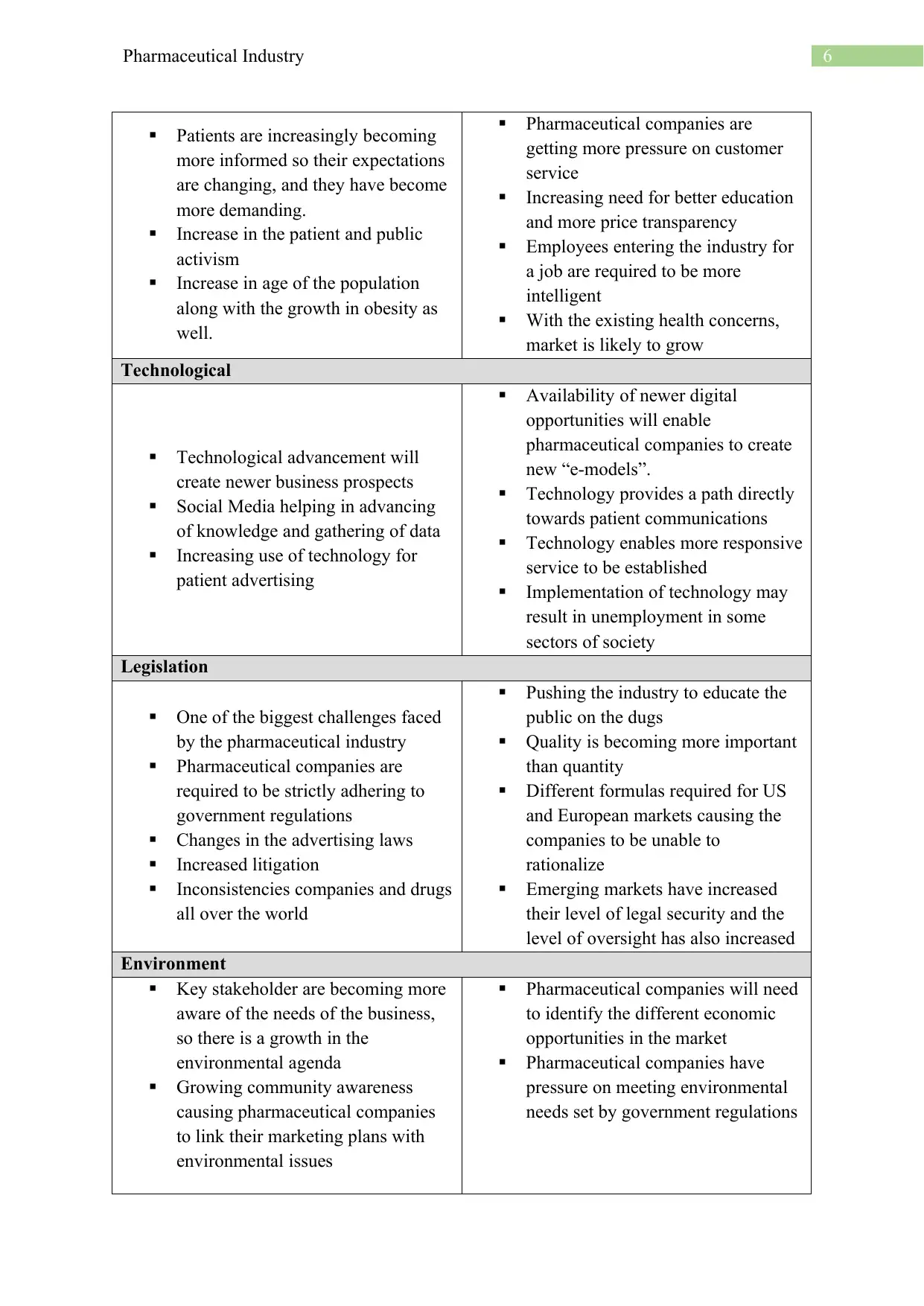
6Pharmaceutical Industry
Patients are increasingly becoming
more informed so their expectations
are changing, and they have become
more demanding.
Increase in the patient and public
activism
Increase in age of the population
along with the growth in obesity as
well.
Pharmaceutical companies are
getting more pressure on customer
service
Increasing need for better education
and more price transparency
Employees entering the industry for
a job are required to be more
intelligent
With the existing health concerns,
market is likely to grow
Technological
Technological advancement will
create newer business prospects
Social Media helping in advancing
of knowledge and gathering of data
Increasing use of technology for
patient advertising
Availability of newer digital
opportunities will enable
pharmaceutical companies to create
new “e-models”.
Technology provides a path directly
towards patient communications
Technology enables more responsive
service to be established
Implementation of technology may
result in unemployment in some
sectors of society
Legislation
One of the biggest challenges faced
by the pharmaceutical industry
Pharmaceutical companies are
required to be strictly adhering to
government regulations
Changes in the advertising laws
Increased litigation
Inconsistencies companies and drugs
all over the world
Pushing the industry to educate the
public on the dugs
Quality is becoming more important
than quantity
Different formulas required for US
and European markets causing the
companies to be unable to
rationalize
Emerging markets have increased
their level of legal security and the
level of oversight has also increased
Environment
Key stakeholder are becoming more
aware of the needs of the business,
so there is a growth in the
environmental agenda
Growing community awareness
causing pharmaceutical companies
to link their marketing plans with
environmental issues
Pharmaceutical companies will need
to identify the different economic
opportunities in the market
Pharmaceutical companies have
pressure on meeting environmental
needs set by government regulations
Patients are increasingly becoming
more informed so their expectations
are changing, and they have become
more demanding.
Increase in the patient and public
activism
Increase in age of the population
along with the growth in obesity as
well.
Pharmaceutical companies are
getting more pressure on customer
service
Increasing need for better education
and more price transparency
Employees entering the industry for
a job are required to be more
intelligent
With the existing health concerns,
market is likely to grow
Technological
Technological advancement will
create newer business prospects
Social Media helping in advancing
of knowledge and gathering of data
Increasing use of technology for
patient advertising
Availability of newer digital
opportunities will enable
pharmaceutical companies to create
new “e-models”.
Technology provides a path directly
towards patient communications
Technology enables more responsive
service to be established
Implementation of technology may
result in unemployment in some
sectors of society
Legislation
One of the biggest challenges faced
by the pharmaceutical industry
Pharmaceutical companies are
required to be strictly adhering to
government regulations
Changes in the advertising laws
Increased litigation
Inconsistencies companies and drugs
all over the world
Pushing the industry to educate the
public on the dugs
Quality is becoming more important
than quantity
Different formulas required for US
and European markets causing the
companies to be unable to
rationalize
Emerging markets have increased
their level of legal security and the
level of oversight has also increased
Environment
Key stakeholder are becoming more
aware of the needs of the business,
so there is a growth in the
environmental agenda
Growing community awareness
causing pharmaceutical companies
to link their marketing plans with
environmental issues
Pharmaceutical companies will need
to identify the different economic
opportunities in the market
Pharmaceutical companies have
pressure on meeting environmental
needs set by government regulations
Paraphrase This Document
Need a fresh take? Get an instant paraphrase of this document with our AI Paraphraser
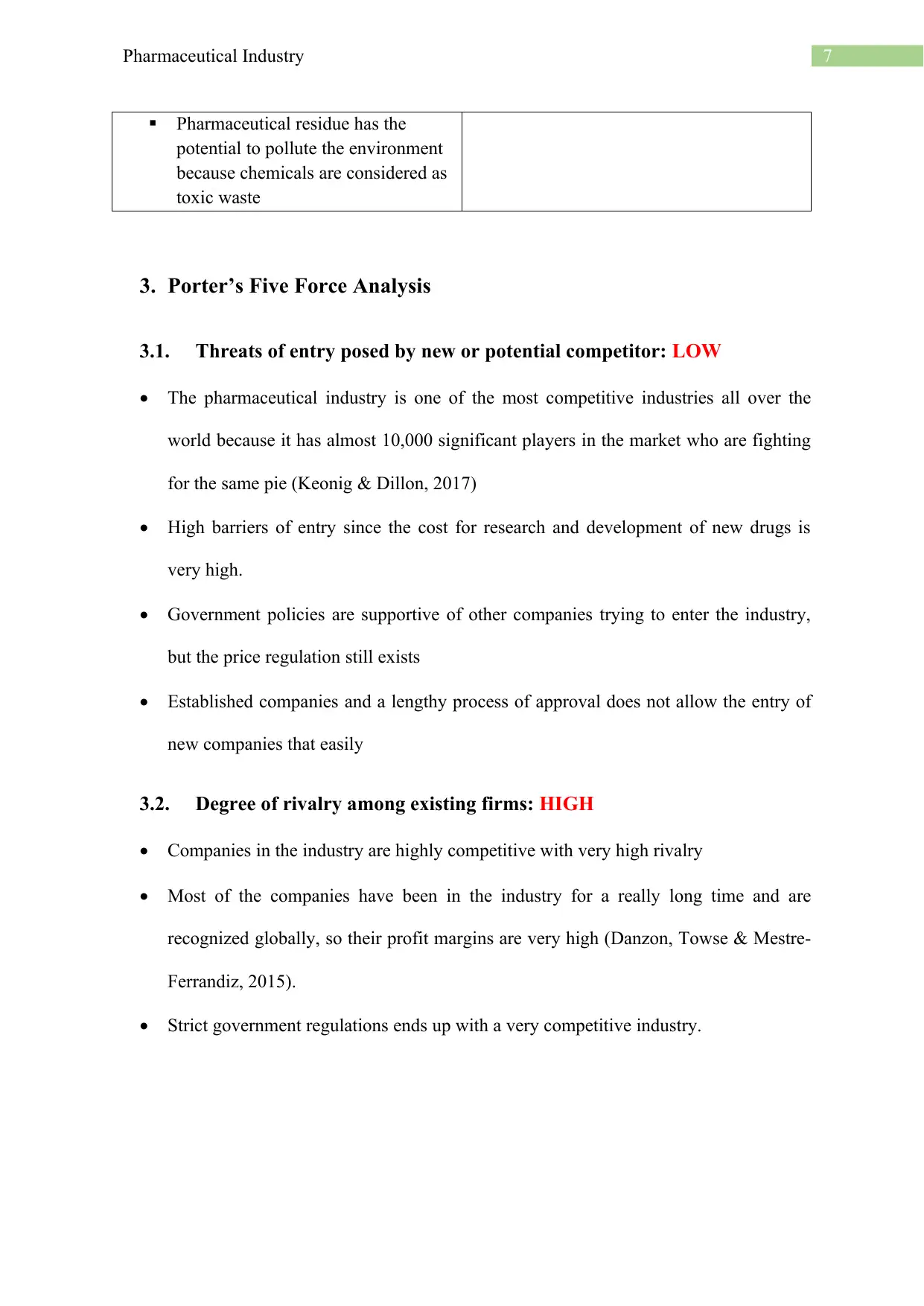
7Pharmaceutical Industry
Pharmaceutical residue has the
potential to pollute the environment
because chemicals are considered as
toxic waste
3. Porter’s Five Force Analysis
3.1. Threats of entry posed by new or potential competitor: LOW
The pharmaceutical industry is one of the most competitive industries all over the
world because it has almost 10,000 significant players in the market who are fighting
for the same pie (Keonig & Dillon, 2017)
High barriers of entry since the cost for research and development of new drugs is
very high.
Government policies are supportive of other companies trying to enter the industry,
but the price regulation still exists
Established companies and a lengthy process of approval does not allow the entry of
new companies that easily
3.2. Degree of rivalry among existing firms: HIGH
Companies in the industry are highly competitive with very high rivalry
Most of the companies have been in the industry for a really long time and are
recognized globally, so their profit margins are very high (Danzon, Towse & Mestre-
Ferrandiz, 2015).
Strict government regulations ends up with a very competitive industry.
Pharmaceutical residue has the
potential to pollute the environment
because chemicals are considered as
toxic waste
3. Porter’s Five Force Analysis
3.1. Threats of entry posed by new or potential competitor: LOW
The pharmaceutical industry is one of the most competitive industries all over the
world because it has almost 10,000 significant players in the market who are fighting
for the same pie (Keonig & Dillon, 2017)
High barriers of entry since the cost for research and development of new drugs is
very high.
Government policies are supportive of other companies trying to enter the industry,
but the price regulation still exists
Established companies and a lengthy process of approval does not allow the entry of
new companies that easily
3.2. Degree of rivalry among existing firms: HIGH
Companies in the industry are highly competitive with very high rivalry
Most of the companies have been in the industry for a really long time and are
recognized globally, so their profit margins are very high (Danzon, Towse & Mestre-
Ferrandiz, 2015).
Strict government regulations ends up with a very competitive industry.
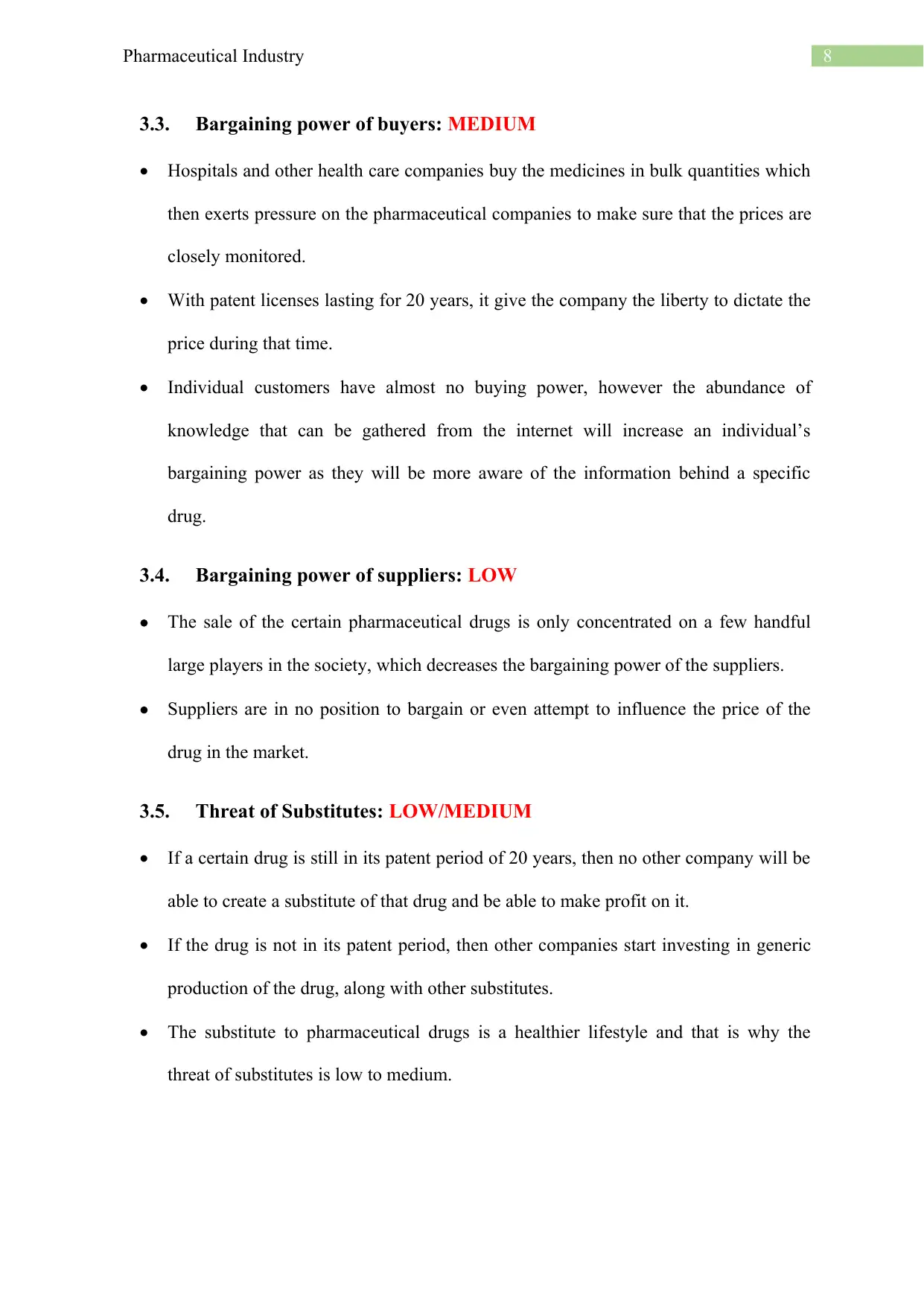
8Pharmaceutical Industry
3.3. Bargaining power of buyers: MEDIUM
Hospitals and other health care companies buy the medicines in bulk quantities which
then exerts pressure on the pharmaceutical companies to make sure that the prices are
closely monitored.
With patent licenses lasting for 20 years, it give the company the liberty to dictate the
price during that time.
Individual customers have almost no buying power, however the abundance of
knowledge that can be gathered from the internet will increase an individual’s
bargaining power as they will be more aware of the information behind a specific
drug.
3.4. Bargaining power of suppliers: LOW
The sale of the certain pharmaceutical drugs is only concentrated on a few handful
large players in the society, which decreases the bargaining power of the suppliers.
Suppliers are in no position to bargain or even attempt to influence the price of the
drug in the market.
3.5. Threat of Substitutes: LOW/MEDIUM
If a certain drug is still in its patent period of 20 years, then no other company will be
able to create a substitute of that drug and be able to make profit on it.
If the drug is not in its patent period, then other companies start investing in generic
production of the drug, along with other substitutes.
The substitute to pharmaceutical drugs is a healthier lifestyle and that is why the
threat of substitutes is low to medium.
3.3. Bargaining power of buyers: MEDIUM
Hospitals and other health care companies buy the medicines in bulk quantities which
then exerts pressure on the pharmaceutical companies to make sure that the prices are
closely monitored.
With patent licenses lasting for 20 years, it give the company the liberty to dictate the
price during that time.
Individual customers have almost no buying power, however the abundance of
knowledge that can be gathered from the internet will increase an individual’s
bargaining power as they will be more aware of the information behind a specific
drug.
3.4. Bargaining power of suppliers: LOW
The sale of the certain pharmaceutical drugs is only concentrated on a few handful
large players in the society, which decreases the bargaining power of the suppliers.
Suppliers are in no position to bargain or even attempt to influence the price of the
drug in the market.
3.5. Threat of Substitutes: LOW/MEDIUM
If a certain drug is still in its patent period of 20 years, then no other company will be
able to create a substitute of that drug and be able to make profit on it.
If the drug is not in its patent period, then other companies start investing in generic
production of the drug, along with other substitutes.
The substitute to pharmaceutical drugs is a healthier lifestyle and that is why the
threat of substitutes is low to medium.
⊘ This is a preview!⊘
Do you want full access?
Subscribe today to unlock all pages.

Trusted by 1+ million students worldwide
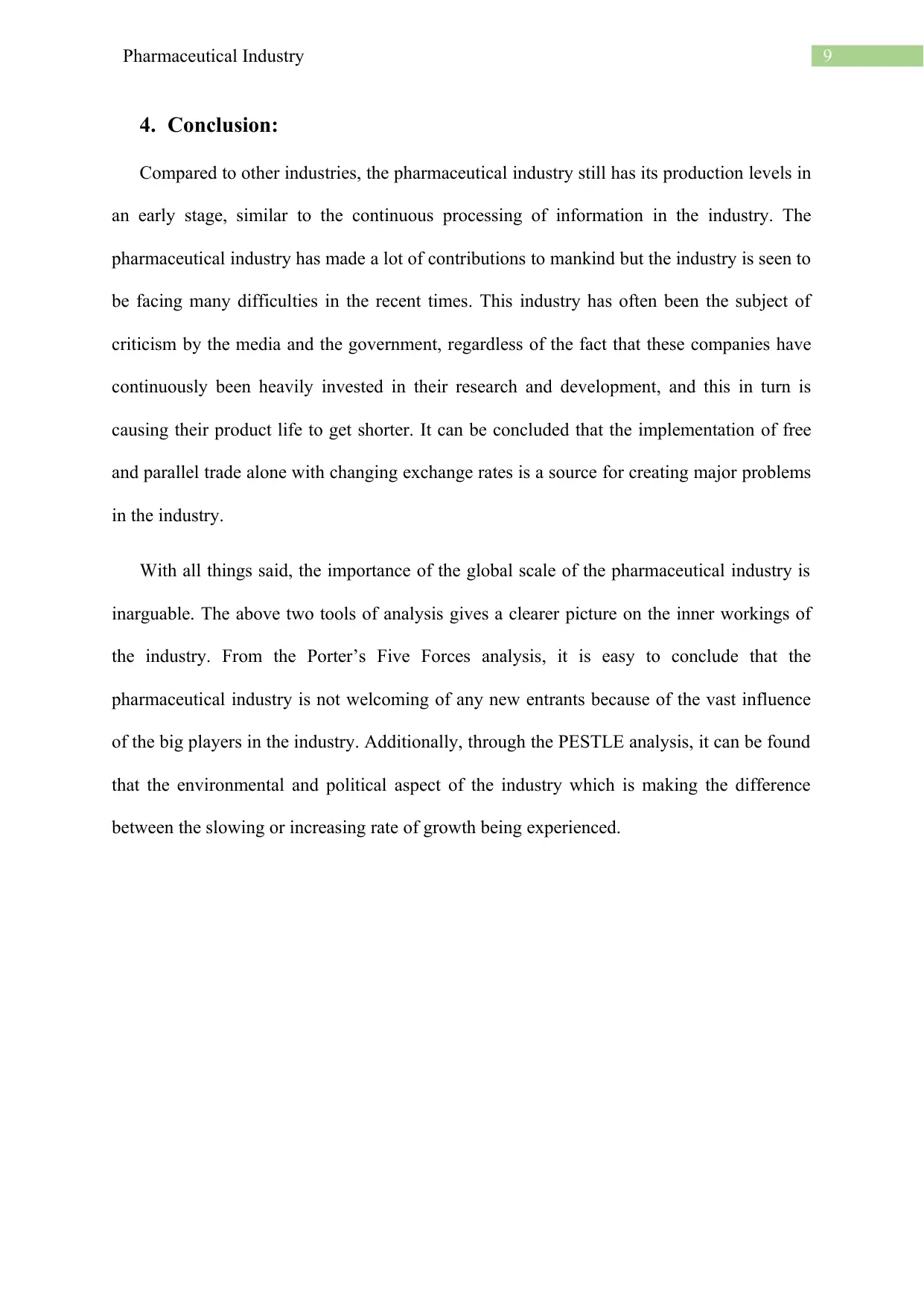
9Pharmaceutical Industry
4. Conclusion:
Compared to other industries, the pharmaceutical industry still has its production levels in
an early stage, similar to the continuous processing of information in the industry. The
pharmaceutical industry has made a lot of contributions to mankind but the industry is seen to
be facing many difficulties in the recent times. This industry has often been the subject of
criticism by the media and the government, regardless of the fact that these companies have
continuously been heavily invested in their research and development, and this in turn is
causing their product life to get shorter. It can be concluded that the implementation of free
and parallel trade alone with changing exchange rates is a source for creating major problems
in the industry.
With all things said, the importance of the global scale of the pharmaceutical industry is
inarguable. The above two tools of analysis gives a clearer picture on the inner workings of
the industry. From the Porter’s Five Forces analysis, it is easy to conclude that the
pharmaceutical industry is not welcoming of any new entrants because of the vast influence
of the big players in the industry. Additionally, through the PESTLE analysis, it can be found
that the environmental and political aspect of the industry which is making the difference
between the slowing or increasing rate of growth being experienced.
4. Conclusion:
Compared to other industries, the pharmaceutical industry still has its production levels in
an early stage, similar to the continuous processing of information in the industry. The
pharmaceutical industry has made a lot of contributions to mankind but the industry is seen to
be facing many difficulties in the recent times. This industry has often been the subject of
criticism by the media and the government, regardless of the fact that these companies have
continuously been heavily invested in their research and development, and this in turn is
causing their product life to get shorter. It can be concluded that the implementation of free
and parallel trade alone with changing exchange rates is a source for creating major problems
in the industry.
With all things said, the importance of the global scale of the pharmaceutical industry is
inarguable. The above two tools of analysis gives a clearer picture on the inner workings of
the industry. From the Porter’s Five Forces analysis, it is easy to conclude that the
pharmaceutical industry is not welcoming of any new entrants because of the vast influence
of the big players in the industry. Additionally, through the PESTLE analysis, it can be found
that the environmental and political aspect of the industry which is making the difference
between the slowing or increasing rate of growth being experienced.
Paraphrase This Document
Need a fresh take? Get an instant paraphrase of this document with our AI Paraphraser
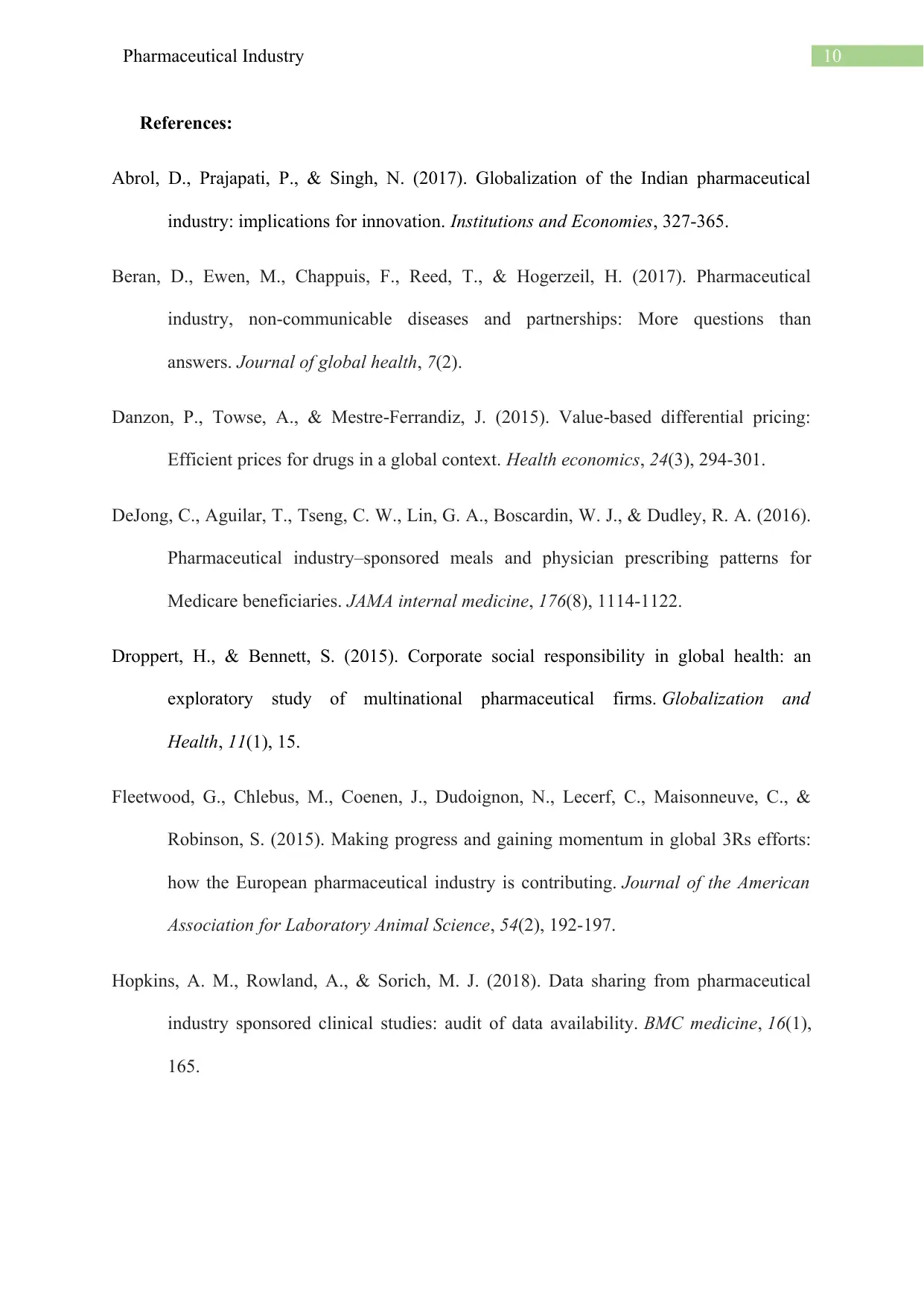
10Pharmaceutical Industry
References:
Abrol, D., Prajapati, P., & Singh, N. (2017). Globalization of the Indian pharmaceutical
industry: implications for innovation. Institutions and Economies, 327-365.
Beran, D., Ewen, M., Chappuis, F., Reed, T., & Hogerzeil, H. (2017). Pharmaceutical
industry, non-communicable diseases and partnerships: More questions than
answers. Journal of global health, 7(2).
Danzon, P., Towse, A., & Mestre Ferrandiz, J. (2015). Value based differential pricing:‐ ‐
Efficient prices for drugs in a global context. Health economics, 24(3), 294-301.
DeJong, C., Aguilar, T., Tseng, C. W., Lin, G. A., Boscardin, W. J., & Dudley, R. A. (2016).
Pharmaceutical industry–sponsored meals and physician prescribing patterns for
Medicare beneficiaries. JAMA internal medicine, 176(8), 1114-1122.
Droppert, H., & Bennett, S. (2015). Corporate social responsibility in global health: an
exploratory study of multinational pharmaceutical firms. Globalization and
Health, 11(1), 15.
Fleetwood, G., Chlebus, M., Coenen, J., Dudoignon, N., Lecerf, C., Maisonneuve, C., &
Robinson, S. (2015). Making progress and gaining momentum in global 3Rs efforts:
how the European pharmaceutical industry is contributing. Journal of the American
Association for Laboratory Animal Science, 54(2), 192-197.
Hopkins, A. M., Rowland, A., & Sorich, M. J. (2018). Data sharing from pharmaceutical
industry sponsored clinical studies: audit of data availability. BMC medicine, 16(1),
165.
References:
Abrol, D., Prajapati, P., & Singh, N. (2017). Globalization of the Indian pharmaceutical
industry: implications for innovation. Institutions and Economies, 327-365.
Beran, D., Ewen, M., Chappuis, F., Reed, T., & Hogerzeil, H. (2017). Pharmaceutical
industry, non-communicable diseases and partnerships: More questions than
answers. Journal of global health, 7(2).
Danzon, P., Towse, A., & Mestre Ferrandiz, J. (2015). Value based differential pricing:‐ ‐
Efficient prices for drugs in a global context. Health economics, 24(3), 294-301.
DeJong, C., Aguilar, T., Tseng, C. W., Lin, G. A., Boscardin, W. J., & Dudley, R. A. (2016).
Pharmaceutical industry–sponsored meals and physician prescribing patterns for
Medicare beneficiaries. JAMA internal medicine, 176(8), 1114-1122.
Droppert, H., & Bennett, S. (2015). Corporate social responsibility in global health: an
exploratory study of multinational pharmaceutical firms. Globalization and
Health, 11(1), 15.
Fleetwood, G., Chlebus, M., Coenen, J., Dudoignon, N., Lecerf, C., Maisonneuve, C., &
Robinson, S. (2015). Making progress and gaining momentum in global 3Rs efforts:
how the European pharmaceutical industry is contributing. Journal of the American
Association for Laboratory Animal Science, 54(2), 192-197.
Hopkins, A. M., Rowland, A., & Sorich, M. J. (2018). Data sharing from pharmaceutical
industry sponsored clinical studies: audit of data availability. BMC medicine, 16(1),
165.
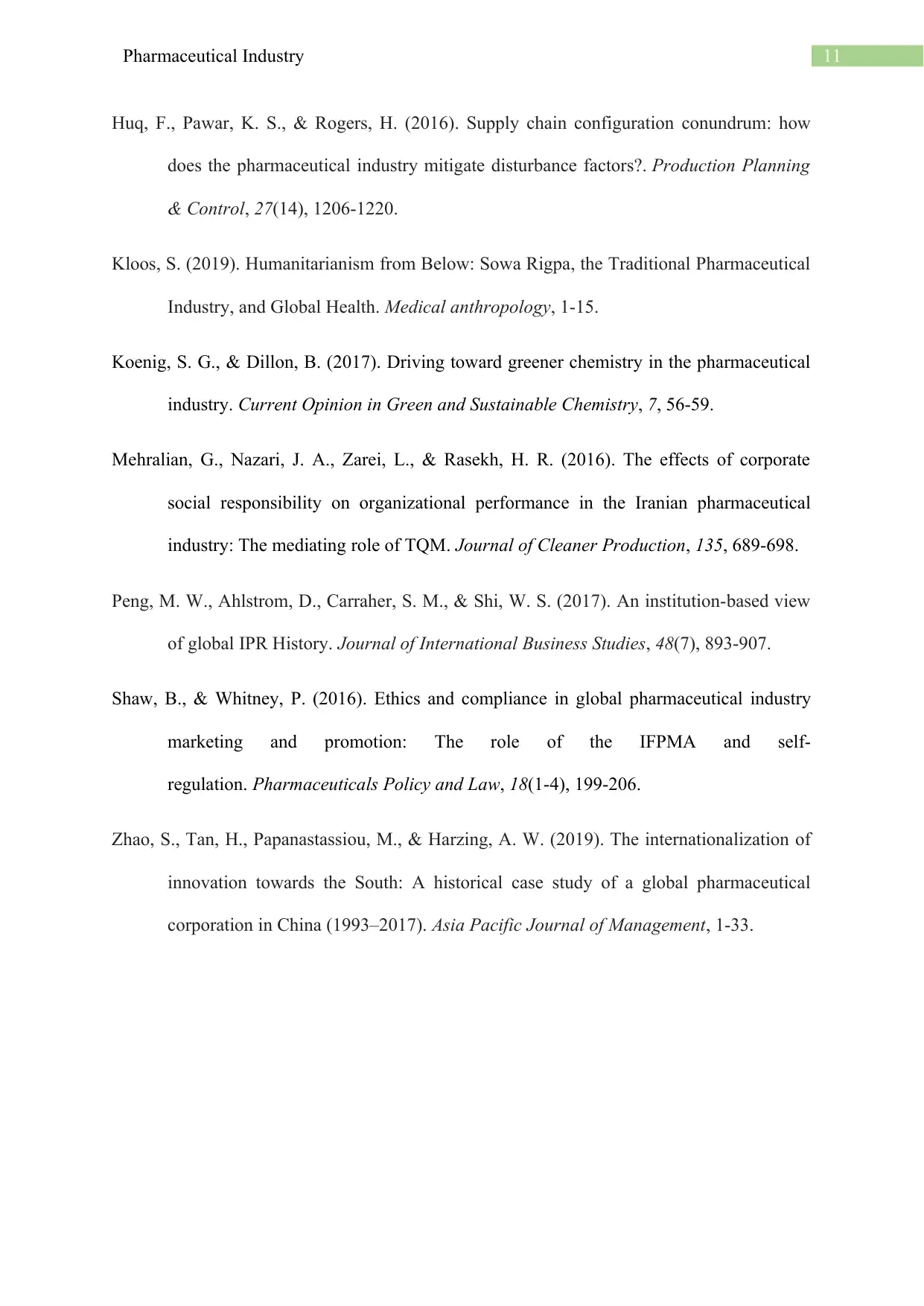
11Pharmaceutical Industry
Huq, F., Pawar, K. S., & Rogers, H. (2016). Supply chain configuration conundrum: how
does the pharmaceutical industry mitigate disturbance factors?. Production Planning
& Control, 27(14), 1206-1220.
Kloos, S. (2019). Humanitarianism from Below: Sowa Rigpa, the Traditional Pharmaceutical
Industry, and Global Health. Medical anthropology, 1-15.
Koenig, S. G., & Dillon, B. (2017). Driving toward greener chemistry in the pharmaceutical
industry. Current Opinion in Green and Sustainable Chemistry, 7, 56-59.
Mehralian, G., Nazari, J. A., Zarei, L., & Rasekh, H. R. (2016). The effects of corporate
social responsibility on organizational performance in the Iranian pharmaceutical
industry: The mediating role of TQM. Journal of Cleaner Production, 135, 689-698.
Peng, M. W., Ahlstrom, D., Carraher, S. M., & Shi, W. S. (2017). An institution-based view
of global IPR History. Journal of International Business Studies, 48(7), 893-907.
Shaw, B., & Whitney, P. (2016). Ethics and compliance in global pharmaceutical industry
marketing and promotion: The role of the IFPMA and self-
regulation. Pharmaceuticals Policy and Law, 18(1-4), 199-206.
Zhao, S., Tan, H., Papanastassiou, M., & Harzing, A. W. (2019). The internationalization of
innovation towards the South: A historical case study of a global pharmaceutical
corporation in China (1993–2017). Asia Pacific Journal of Management, 1-33.
Huq, F., Pawar, K. S., & Rogers, H. (2016). Supply chain configuration conundrum: how
does the pharmaceutical industry mitigate disturbance factors?. Production Planning
& Control, 27(14), 1206-1220.
Kloos, S. (2019). Humanitarianism from Below: Sowa Rigpa, the Traditional Pharmaceutical
Industry, and Global Health. Medical anthropology, 1-15.
Koenig, S. G., & Dillon, B. (2017). Driving toward greener chemistry in the pharmaceutical
industry. Current Opinion in Green and Sustainable Chemistry, 7, 56-59.
Mehralian, G., Nazari, J. A., Zarei, L., & Rasekh, H. R. (2016). The effects of corporate
social responsibility on organizational performance in the Iranian pharmaceutical
industry: The mediating role of TQM. Journal of Cleaner Production, 135, 689-698.
Peng, M. W., Ahlstrom, D., Carraher, S. M., & Shi, W. S. (2017). An institution-based view
of global IPR History. Journal of International Business Studies, 48(7), 893-907.
Shaw, B., & Whitney, P. (2016). Ethics and compliance in global pharmaceutical industry
marketing and promotion: The role of the IFPMA and self-
regulation. Pharmaceuticals Policy and Law, 18(1-4), 199-206.
Zhao, S., Tan, H., Papanastassiou, M., & Harzing, A. W. (2019). The internationalization of
innovation towards the South: A historical case study of a global pharmaceutical
corporation in China (1993–2017). Asia Pacific Journal of Management, 1-33.
⊘ This is a preview!⊘
Do you want full access?
Subscribe today to unlock all pages.

Trusted by 1+ million students worldwide
1 out of 12
Related Documents
Your All-in-One AI-Powered Toolkit for Academic Success.
+13062052269
info@desklib.com
Available 24*7 on WhatsApp / Email
![[object Object]](/_next/static/media/star-bottom.7253800d.svg)
Unlock your academic potential
Copyright © 2020–2025 A2Z Services. All Rights Reserved. Developed and managed by ZUCOL.



